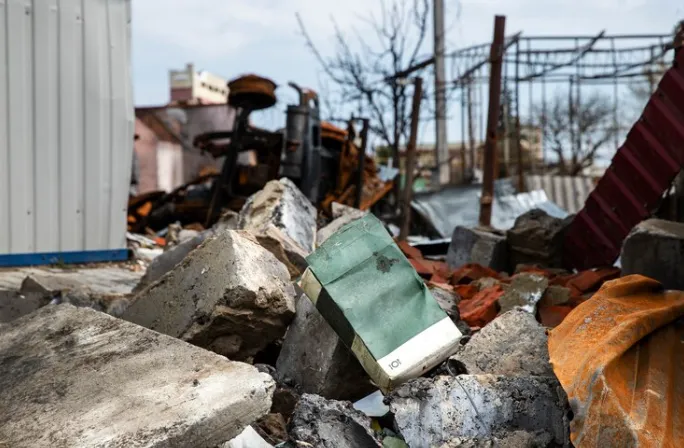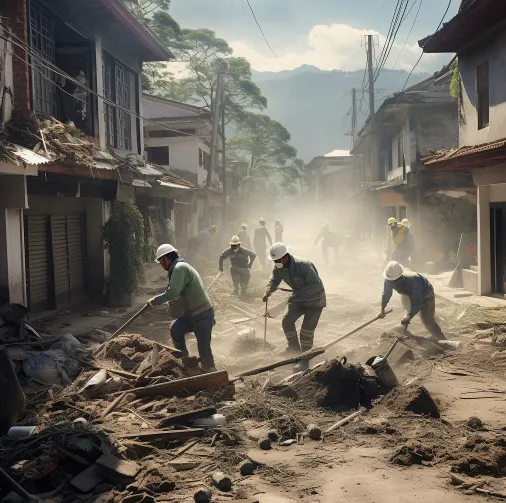In the wake of an earthquake, one of the most critical tasks is debris handling. Efficient and safe cleanup processes are essential not only for restoring normalcy but also for ensuring the well-being of affected communities. This comprehensive guide provides practical insights and step-by-step strategies for safe debris handling in areas affected by earthquakes. It begins by emphasizing the importance of safety protocols and the need for a well-organized response plan. From assessing the type and volume of debris to coordinating disposal methods, the guide navigates through the intricacies of debris management. It delves into the utilization of specialized equipment and the establishment of designated disposal sites, ensuring an environmentally conscious approach. Moreover, the guide addresses the importance of community involvement, providing strategies for engaging residents in the cleanup process and fostering a sense of collective responsibility. By following the guidance offered in this comprehensive resource, communities can efficiently and safely navigate the challenging task of debris handling after an earthquake, contributing to the restoration of both physical and communal well-being.

Understanding the Importance of Safe Debris Handling
The Significance of Swift Cleanup Post-Earthquake
Swift debris cleanup is crucial for several reasons. This section delves into the importance of rapid and effective debris handling, including preventing further damage, restoring infrastructure, and supporting community recovery. In the aftermath of an earthquake, timely debris removal is paramount to prevent additional harm and mitigate potential hazards. The guide underscores the significance of swift cleanup in reducing the risk of secondary disasters, such as floods or structural instability caused by displaced debris. Moreover, efficient debris handling plays a pivotal role in restoring critical infrastructure, allowing for the swift resumption of essential services and normalcy in the affected areas. The guide also highlights the psychological impact of debris accumulation on the affected community, emphasizing the importance of a prompt cleanup process in fostering a sense of recovery and resilience. By addressing these multifaceted aspects, the section emphasizes that the speed and efficacy of debris cleanup operations are integral to the overall success of post-earthquake recovery efforts and the well-being of impacted communities.Swift debris cleanup is crucial for several reasons. This section delves into the importance of rapid and effective debris handling, including preventing further damage, restoring infrastructure, and supporting community recovery.
Safety First: Prioritizing Human Well-being
Before diving into the cleanup process, safety must be the top priority. Explore the importance of a safety-first approach, addressing potential hazards, and implementing measures to protect the well-being of cleanup crews and residents. This section underscores the critical emphasis on safety as the foremost consideration before initiating any debris cleanup operations. It delves into the potential hazards associated with post-earthquake debris, such as unstable structures, sharp objects, or hazardous materials, highlighting the need for a thorough risk assessment. The guide explores the implementation of comprehensive safety measures, including the use of personal protective equipment, proper training for cleanup crews, and the establishment of restricted zones to minimize risks. Emphasizing the importance of communication and emergency protocols, the section aims to create awareness about potential dangers and ensures a coordinated and efficient response to any unforeseen circumstances during the cleanup process. By adopting a safety-first approach, cleanup efforts not only protect the well-being of the workforce but also contribute to a more secure and resilient environment for residents and communities affected by earthquakes.
Assessing the Extent of Debris
Surveying the Damage: Initial Assessment
The first step in safe debris handling is assessing the extent of the damage. Learn how to conduct an initial survey, categorize debris types, and prioritize areas for cleanup, ensuring a systematic and efficient approach. This guide underscores the pivotal role of a comprehensive damage assessment in initiating safe debris handling after an earthquake. It provides practical insights into conducting an initial survey to gauge the extent of destruction, categorizing debris based on types and sizes, and prioritizing areas for cleanup. By systematically evaluating the affected zones, responders can strategically allocate resources and manpower, addressing the most critical areas first. The guide emphasizes the importance of collaboration between local authorities, emergency responders, and community members to gather accurate and timely information during the assessment phase. This systematic approach not only ensures a safer cleanup process by identifying potential hazards but also contributes to the overall efficiency of debris handling operations in the aftermath of an earthquake.
Identifying Hazardous Materials
Debris handling becomes more complex when hazardous materials are involved. This section provides insights into identifying and managing hazardous materials safely, minimizing risks during cleanup operations.
Organizing Cleanup Crews and Resources
Mobilizing Cleanup Crews
Efficient cleanup requires well-organized teams. Explore strategies for mobilizing cleanup crews, including training, assigning roles, and coordinating efforts to maximize effectiveness and minimize downtime. This section delves into the crucial aspect of team mobilization for efficient debris cleanup following an earthquake. It emphasizes the significance of structured training programs to equip cleanup crews with the necessary skills and safety protocols. The guide explores strategies for assigning specific roles and responsibilities within the cleanup teams, ensuring that each member contributes effectively to the overall operation. Coordination is highlighted as a key factor, emphasizing the importance of clear communication channels, regular briefings, and a centralized command structure to streamline efforts and minimize downtime. By implementing these strategies, organizations and communities can not only enhance the efficiency of cleanup operations but also foster a safer and more collaborative environment for the cleanup crews working to restore affected areas after an earthquake.
Resource Allocation and Logistics
Proper allocation of resources is paramount. Learn how to strategically deploy equipment, tools, and personnel, optimizing logistics for smooth debris handling operations in earthquake-affected areas.

Debris Removal Techniques
Manual Debris Removal
In the immediate aftermath of an earthquake, manual debris removal is often the most practical approach. This section provides techniques for safe manual removal, including proper lifting, carrying, and disposal methods. Recognizing the urgency and practicality of manual debris removal in the immediate aftermath of an earthquake, this guide offers essential techniques to ensure the safety of cleanup crews. It emphasizes proper lifting and carrying methods to prevent injuries and strains, considering the physical demands of manual debris removal. The guide also addresses safe disposal methods, underscoring the importance of designated disposal sites and adherence to environmental regulations. By providing practical insights into these manual removal techniques, the section aims to empower cleanup crews with the knowledge and skills necessary to navigate the challenges of immediate debris removal in a safe and efficient manner.
Utilizing Heavy Machinery
As cleanup progresses, heavy machinery becomes essential. Explore the safe operation of bulldozers, cranes, and excavators, ensuring efficient debris removal without compromising safety standards.
Eco-Friendly Disposal Methods
Environmental sustainability is a key consideration in debris handling. Discover eco-friendly disposal methods, including recycling, repurposing, and responsible disposal of debris to minimize the environmental impact. This section underscores the critical importance of incorporating environmental sustainability into debris handling strategies post-earthquake. It explores eco-friendly disposal methods, emphasizing the principles of recycling and repurposing materials whenever possible. The guide highlights the benefits of responsible disposal practices, such as reducing the burden on landfills and minimizing the environmental impact of debris removal operations. By adopting these eco-conscious methods, communities and organizations can contribute to long-term environmental sustainability while addressing the immediate challenges of debris management after an earthquake. This section serves as a guide to foster a holistic approach that not only restores affected areas efficiently but also aligns with a commitment to preserving the environment for future generations.
Ensuring Structural Stability
Structural Assessment Before Cleanup
Before initiating cleanup operations, structural stability must be assessed. Understand the importance of evaluating buildings and structures for stability, ensuring a safe environment for cleanup crews. This section emphasizes the critical step of assessing structural stability before commencing cleanup operations following an earthquake. It underscores the importance of thorough evaluations of buildings and structures to identify potential hazards and ensure a safe environment for cleanup crews. The guide delves into the significance of engaging structural engineers or qualified professionals to conduct assessments, considering factors such as structural integrity, stability, and the risk of collapse. By prioritizing this crucial step, cleanup crews can navigate the debris removal process with greater safety, minimizing the risks associated with unstable structures and creating a secure environment for effective cleanup operations.
Stabilization Measures During Cleanup
Implement stabilization measures to enhance safety during cleanup. This section provides insights into temporary structural reinforcements and support systems to prevent further collapse or hazards.
Community Engagement and Communication
Transparent Communication with Residents
Open and transparent communication is crucial during debris cleanup. Learn effective strategies for communicating with residents, addressing concerns, and keeping the community informed about the progress and safety measures in place. This section highlights the paramount importance of open and transparent communication throughout the debris cleanup process following an earthquake. It explores effective strategies for engaging with residents, addressing their concerns, and providing timely updates on the progress of cleanup operations. The guide emphasizes the need for clear and accessible communication channels, including community meetings, informational materials, and digital platforms. It also underscores the importance of addressing safety measures in a transparent manner to instill confidence and cooperation within the community. By adopting these communication strategies, cleanup teams can build trust, alleviate concerns, and foster a collaborative atmosphere, ensuring that residents are well-informed and actively involved in the recovery process.
Involving the Community in Cleanup Efforts
Engaging the local community in cleanup efforts fosters a sense of unity and shared responsibility. Explore ways to involve residents in the cleanup process, promoting community resilience and collaboration.

